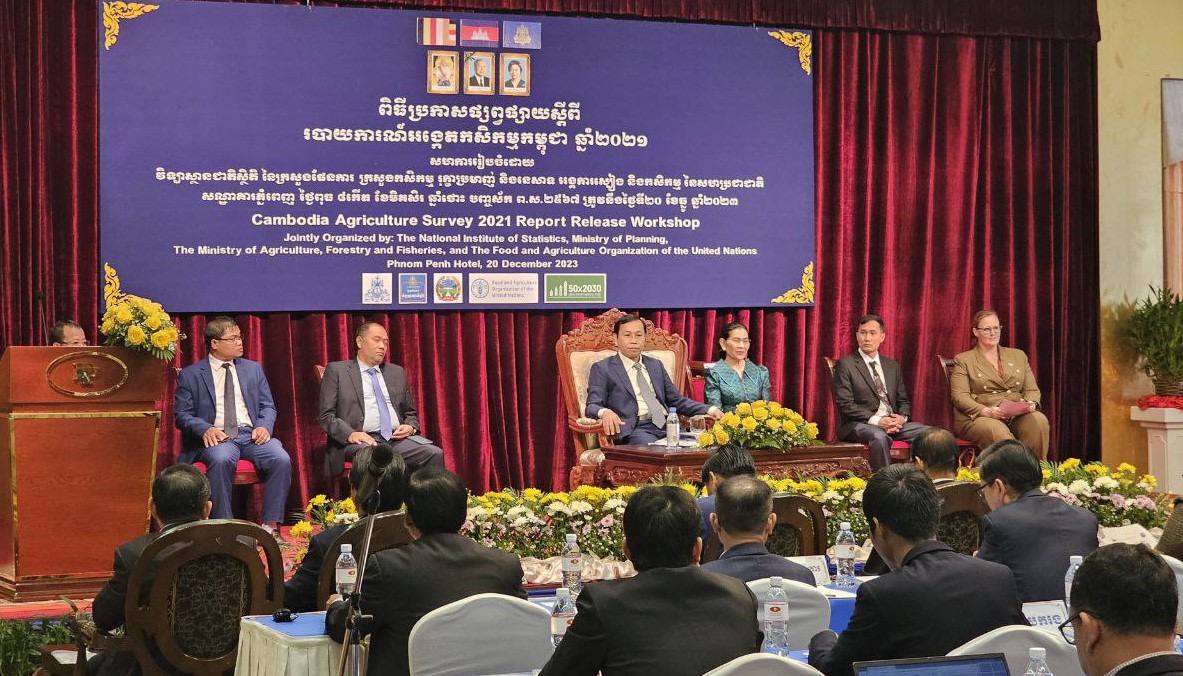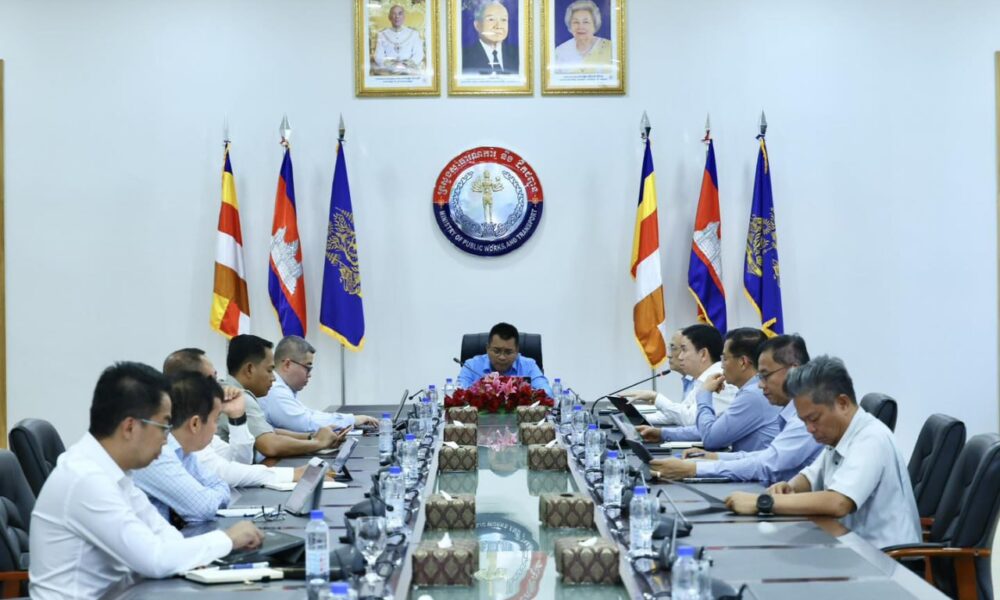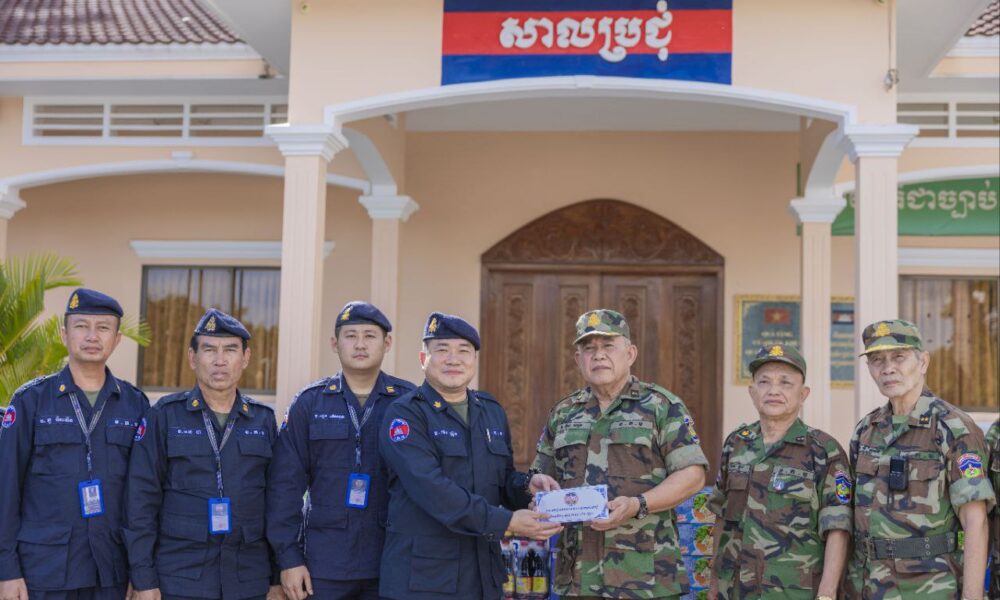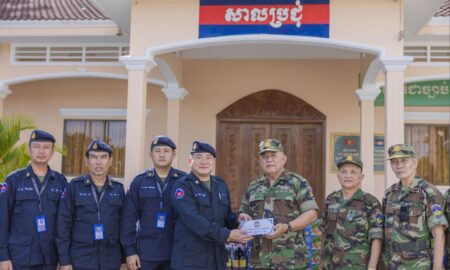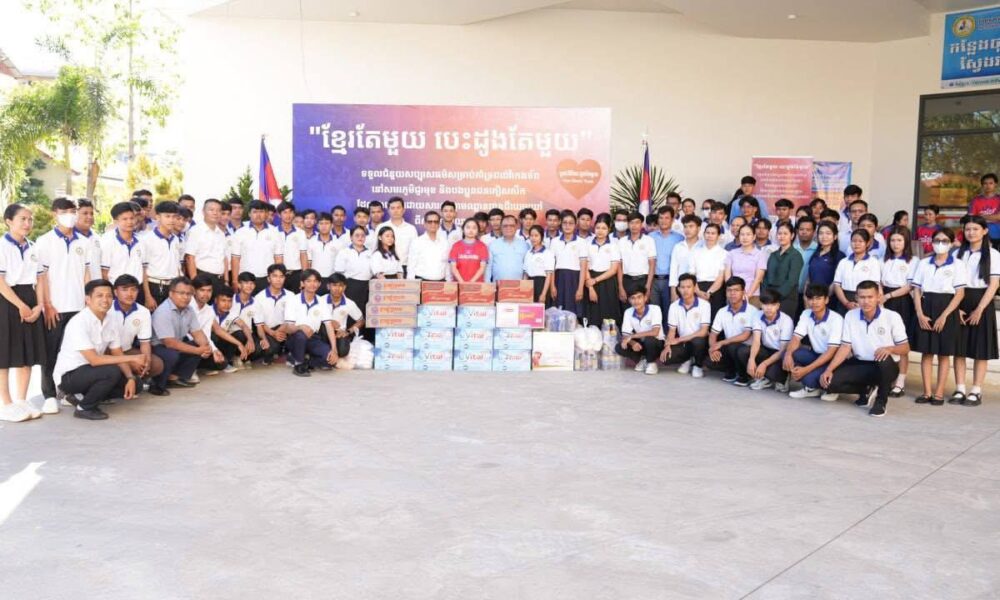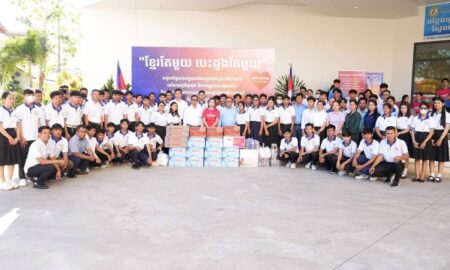Phnom Penh, 20 December 2023 – On 20 December 2023 the National Institute of Statistics (NIS) of the Ministry of Planning (MoP), in partnership with the Ministry of Agriculture, Forestry and Fisheries (MAFF), and with technical support from the Food and Agriculture Organization of the United Nations (FAO), under the scope of the 50×2030 Initiative to Close the Agricultural Data Gap organized the Cambodia Agriculture Survey 2021 (CAS 2021) Report Release Workshop. The 50×2030 is a multi-donor initiative implemented through a unique partnership between the World Bank, FAO, and the International Fund for Agricultural Development (IFAD), with the aim to build national statistical capacity and to establish an efficient and durable national agricultural data collection system.
The CAS 2021 collected information on crop cultivation, livestock and poultry raising, aquaculture and capture fishing, impact of external shocks on agriculture, labour, economy and more. The survey method involved the selection of a representative sample of Enumeration Areas (EA) throughout Cambodia from the 2019 General Population Census Sampling Frame encompassing around 14 500 villages and 38 000 Enumeration Areas (EAs). Targeting households engaged in agriculture, fishery, or aquaculture, the CAS 2021 employed a two-stage stratified sampling procedure, ultimately selecting 1 381 EAs and aiming for a total sample size of 16 572 households. Data collection was conducted during November and December 2021 by a total of 429 staff from the Provincial Departments of Planning and Provincial Departments of Agriculture, Forestry and Fisheries.
The CAS 2021 estimated a total of 2 277 000 household agricultural holdings in Cambodia, or approximately 57 percent of all households in the country (3 553 021 households as per the General Population Census of Cambodia 2019). Crop activity was reported on 93 percent of all household agricultural holdings in Cambodia, while 83 percent reported raising livestock, poultry, or insects. An estimated 21 percent were involved in capture fishing activity and 4 percent in aquaculture.
The survey assessed that around one-quarter (27 percent) of the Cambodian agricultural households reported that their agricultural income contributed less to their total household income than during the previous year. The agricultural households were also asked to estimate the share of their total household income that was accounted for by their agricultural income: an estimated 35 percent of households reported that about half of their total household income was accounted for by agricultural income, 18 percent reported that most or almost all of their total household income was accounted for by agricultural income, and only 4 percent reported that all of their total household income was accounted for by agricultural income.
The survey also touched the topic of land ownership: nearly 98 percent of agricultural households either own or have an owner-like possession of their agricultural land. Significantly, there’s been a marked increase in land prices. Land purchased for USD 2 600 per hectare in 2000 or earlier jumped to USD 7 500 USD per hectare for transactions in 2021.
The survey also pointed out Cambodia’s dependence on occasional agricultural workers. From July 2020 to June 2021, 464 000 agricultural holdings nationwide employed occasional workers. The Tonle Sap Lake Zone had the highest engagement with 204 000 holdings, while the Coastal Zone had the least at 19 000. Diving into workforce demographics, 2 633 100 occasional workers were engaged across different agricultural holdings. The gender distribution is almost even, with 49.2 percent female and 50.8 percent male workers. However, regional differences are notable: the Plateau and Mountainous Zone employs 62.8 percent female workers, while the Coastal Zone sees male workers making up 69.5 percent of its labour force. These findings emphasize the varied gender roles in agricultural employment throughout Cambodia.
COVID-19’s Influence on Cambodia’s Agriculture
The recent CAS 2021 results reveal the multifaceted challenges Cambodia’s agricultural sector faced over the year. Thirty-five percent of agricultural household holdings experienced disruptions from various events, with drought affecting 244 000 holdings, floods impacting 206 000, and COVID-19 issues directly affecting 131 000 holdings. These findings, encompassing the tangible effects of both natural calamities and the pandemic, underscore the resilience and adaptability of the nation’s agricultural community.
Ms. Rebekah Bell, FAO Representative in Cambodia emphasized that “As technological progress accelerates, our reliance on robust agricultural data grows. It’s this symbiotic relationship that allows us to adapt, innovate, and steer Cambodia’s agricultural sector toward a sustainable and prosperous future.”
Promoting national statistical capacity development
His Excellency Nor Vanndy at the National Institute of statistics, Ministry of Planning commented that “the collaboration between NIS-MOP, MAFF, FAO and other development partners through the 50×2030 initiative working on CAS 2021 is a shining example of teamwork that has brought significant improvements to our institute. Through this project, we have seen better quality in our fieldwork and increased skills in data analysis. These steps forward are crucial as they directly strengthen our ministry’s ability to make well-informed decisions and develop policies based on reliable data.”
As the CAS evolves, the potential applications of the data will broaden and may be integrated with other research efforts, such as the Cambodian Agriculture Census 2023. Mr. Mak Mony, who serves as the Director of the Department of Planning and Statistics within the Ministry of Agriculture, Forestry, and Fisheries, has expressed the synergy between these diverse datasets, emphasizing their role in strengthening planning and policymaking at both the national and sub-national levels. “In the midst of evolving global challenges like climate shifts and market fluctuations, our agricultural landscape requires steadfast support. Our dedication to elevating the sector is unwavering, and the depth and breadth of data we gather is instrumental in guiding our strategies. Every piece of information pushes us closer to a resilient and thriving agricultural future for Cambodia.”
High quality data, freely accessible
The 50×2030 Initiative aims to fill the agricultural data gap in 50 low and lower-middle income countries by the year 2030, and to inform their agriculture-related Sustainable Development Goals (SDGs). Cambodia was the first country to join the initiative in Asia. One of the cornerstones of the 50×2030 initiative is to provide data free of charge so that research institutions, policy makers and development partners can use up to date and high-quality data to make accurate and informed decisions.
The CAS 2021 data is to be freely available to access via two portals. The first is to view and download the tabulated data through Cambodia’s National Indicator Reporting Platform (CAMSTAT – accessible at http://camstat.nis.gov.kh/) and the second is to view and download the full anonymized microdata and associated metadata via Cambodia’s microdata catalogue (accessible at https://microdata.nis.gov.kh/index.php/catalog).


